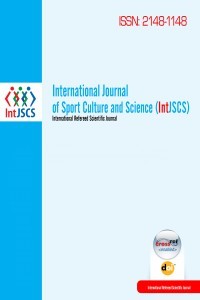Prevalence of Mainstream Gender-Related Issues in Sports: Female Student Athletes’ Perceptions
Female students, athletes, gender sports,
___
- Akoijam S (n.d.). Participation level of Indian women in sports in National and International Arena. International Journal of English Language, Literature, and Humanities , 199-211.
- Ashitha (2012). Women and Sports - Gender Politics in Contemporary Kerala. 2nd International Conference on Social Science and Humanity IPEDR vol.31 (2012) © (2012) (pp. 159-162). Singapore: IACSIT Presse.
- Coakley J (2009). Gender and sports. In J. Coakley, Sports in Society: Issues and Controvercies (pp. 232-272). New York: Mc Graw Hill.
- Dubey BK (2003). Problems of female in sports participation: exploring the capability approach. Horizon Palaestra: International Journal of Health, Sports and Physical Education, 38-42.
- Garg RP, Kumar N, Rani J (n.d.). A Study of Women Contribution Sports in Haryana. Shiv Shakti, International Journal in Multidisciplinary and Academic Research (SSIJMAR) , pp. 1- 9, Vol. 2, No. 2.
- Gupta R (2013). Bowled Out of the Game: Nationalism and Gender Equality in Indian Cricket. Berkeley Journal of Entertainment and Sports Law, 89-120.
- Hill J (2016). Gender and Sports. In P. Craig, Sports sociology (pp. 115-129). Califonia: SAGE.
- Kosofsky S (1993 ). Toward Gender Equality in Professional Sports . Hastings Women’s Law Journal, 209-247.
- Lengermann PM, Brantley JN (2011). Contemporary Feminist Theory. In G. Ritzer, Sociological Theory (pp. 443-489). Jaipur: Rawat Bookseller.
- Messner MA (1988). Sports and Male Domination: The Female Athlete as Contested Ideological Terrain. Sociology of Sport Journal, 197-211.
- Rayburn B, Chen S, Phillips C (2015 ). Female College Athletes’ Perceptions on Gender Stereotypes and Discrimination in Collegiate Athletics. International Journal of Business and Social Science, 28-36.
- Sapaaij R (2012). The glue that hold the community together? sports and sustainability in rural Australia. In R. Sapaaij, The social impact of sport (pp. 24-28). London: Routledge.
- Scraton S, Flintoff A (2013). Gender, Feminist Theory, and Sport. In D. L. Carrington., A Companion to Spor (pp. 96-111). Blackwell Publishing Ltd.
- Singh SN, Singh V (2010). Scene and support: Indian women sports. International Journal of Physical Education, Vol. 3 No. 1and2, 76-80.
- Women’s Sport and Fitness Foundation (2008, August). Barriers to sports participation for women and girls. Retrieved April 23, 2018, from www.lrsport.org: https://www.lrsport.org/uploads/barriers-to-sports-participation-for-women-girls
- ISSN: 2148-1148
- Başlangıç: 2013
- Yayıncı: Uluslararası Bilim Kültür ve Spor Derneği (UBİKS)
Saeed SAHEB BAYATI, Gholamreza KHAKSARY, Majid SOLEYMAN
İzzet KIRKAYA, Deniz ŞİMŞEK, Günay YILDIZER, Elvin Onarıcı GÜNGÖR
Yeliz DOĞRU, Murat AKYÜZ, Öznur AKYÜZ, Murat TAŞ, Cansu ÇOBAN, Atilla Orkun DİLBER
Fırat AKÇA, Ersan ARSLAN, Dicle ARAS
Shahla NAGHIBI, Mina HAKAKZADEH, Mohammad Ebrahim RAZAGHI
